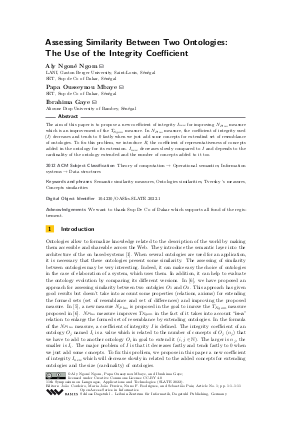Assessing Similarity Between Two Ontologies: The Use of the Integrity Coefficient
Authors Aly Ngoné Ngom, Papa Ousseynou Mbaye, Ibrahima Gaye
-
Part of:
Volume:
11th Symposium on Languages, Applications and Technologies (SLATE 2022)
Part of: Series: Open Access Series in Informatics (OASIcs)
Part of: Conference: Symposium on Languages, Applications and Technologies (SLATE) - License:
 Creative Commons Attribution 4.0 International license
Creative Commons Attribution 4.0 International license
- Publication Date: 2022-07-27
File

PDF
OASIcs.SLATE.2022.1.pdf
- Filesize: 0.93 MB
- 11 pages
Document Identifiers
Subject Classification
ACM Subject Classification
- Theory of computation → Operational semantics
- Information systems → Data structures
Keywords
- Semantic similarity measures
- Ontologies similarities
- Tversky ’s measures
- Concepts similarities
Metrics
- Access Statistics
-
Total Accesses (updated on a weekly basis)
0Document
0Metadata
Abstract
The aim of this paper is to propose a new coefficient of integrity I_{new} for improving N_{Plus} measure which is an improvement of the T_{Ngom} measure. In N_{Plus} measure, the coefficient of integrity used (I) decreases and tends to 0 fastly when we just add some concepts for extendind set of resemblance of ontologies. To fix this problem, we introduce R, the coefficient of representativeness of concepts added in the ontology for its extension. I_{new} decreases slowly compared to I and depends to the cardinality of the ontology extended and the number of concepts added to it too.
Cite As Get BibTex
Aly Ngoné Ngom, Papa Ousseynou Mbaye, and Ibrahima Gaye. Assessing Similarity Between Two Ontologies: The Use of the Integrity Coefficient. In 11th Symposium on Languages, Applications and Technologies (SLATE 2022). Open Access Series in Informatics (OASIcs), Volume 104, pp. 1:1-1:11, Schloss Dagstuhl – Leibniz-Zentrum für Informatik (2022)
https://doi.org/10.4230/OASIcs.SLATE.2022.1
BibTex
@InProceedings{ngom_et_al:OASIcs.SLATE.2022.1,
author = {Ngom, Aly Ngon\'{e} and Mbaye, Papa Ousseynou and Gaye, Ibrahima},
title = {{Assessing Similarity Between Two Ontologies: The Use of the Integrity Coefficient}},
booktitle = {11th Symposium on Languages, Applications and Technologies (SLATE 2022)},
pages = {1:1--1:11},
series = {Open Access Series in Informatics (OASIcs)},
ISBN = {978-3-95977-245-7},
ISSN = {2190-6807},
year = {2022},
volume = {104},
editor = {Cordeiro, Jo\~{a}o and Pereira, Maria Jo\~{a}o and Rodrigues, Nuno F. and Pais, Sebasti\~{a}o},
publisher = {Schloss Dagstuhl -- Leibniz-Zentrum f{\"u}r Informatik},
address = {Dagstuhl, Germany},
URL = {https://drops.dagstuhl.de/entities/document/10.4230/OASIcs.SLATE.2022.1},
URN = {urn:nbn:de:0030-drops-167474},
doi = {10.4230/OASIcs.SLATE.2022.1},
annote = {Keywords: Semantic similarity measures, Ontologies similarities, Tversky ’s measures, Concepts similarities}
}
Author Details
- LANI, Gaston Berger University, Saint-Louis, Sénégal
- SET, Sup de Co of Dakar, Sénégal
Acknowledgements
We want to thank Sup De Co of Dakar which supports all fund of the registrement.
References
-
Khadim Dramé. Contribution à la construction d'ontologies et à la recherche d'information: application au domaine médical. PhD thesis, Université De Bordeaux, 2014.

-
I. V. Levenshtein. Binary codes capable of correcting deletions, insertions, and reversals. In Cybernetics and Control Theory, 10(8), pages 707-710, 1966.

-
A. Maedche and S. Staab. Measuring similarity between ontologies. In A. Gómez-Pérez and V.R. Benjamins, editors, Knowledge Engineering and Knowledge Management: Ontologies and the Semantic Web. EKAW 2002. Lecture Notes in Computer Science, vol 2473. Springer, Berlin, Heidelberg, pages 251-263, 2002.

-
A. N. Ngom. Etude des mesures de similarité sémantique basée sur les arcs. In CORIA, Paris, France, pages 535-544, 2015.

-
A. N. Ngom, G. Kaladzavi, F.K. Sangare, and M. Lo. Assessing similarity value between two ontologies. In The 10th International Joint Conference on Knowledge Discovery, Knowledge Engineering and Knowledge Management (IC3k 2018) - Volume 2:KEOD, pages 343-350, 2018.

-
Aly Ngoné Ngom, Fatou Kamara-Sangaré, and Moussa Lo. Proposition of a method for assessing similarity between two ontologies. In 4th Annual Conf. on Computational Science and Computational Intelligence (CSCI'17) | Dec 14-16, 2017 | Las Vegas, Nevada, USA, pages 174-179, 2017.

-
A. Tversky. Features of similarity. In Psychological Review, 84(4), pages 327-352, 1977.

-
Z. Wu and M. Palmer. Verbs semantics and lexical selection. In U.A.f.C.L. Stroudsburg, PA (ed.), In Proceedings of the 32nd annual meeting on ACL, volume 2 de ACL '94, pages 133-138, 1994.

